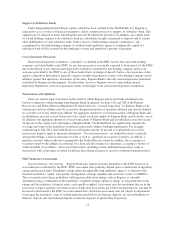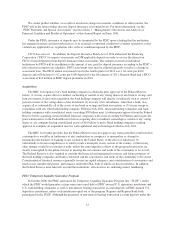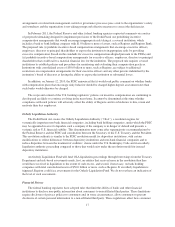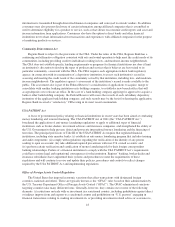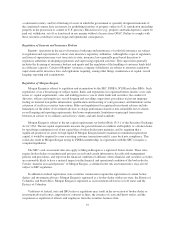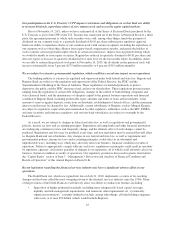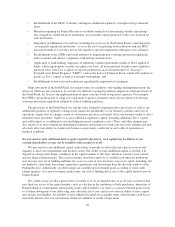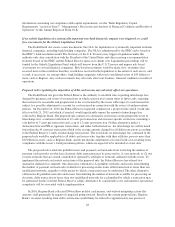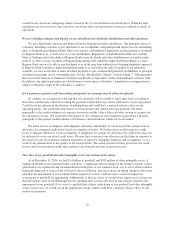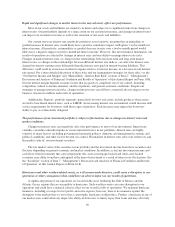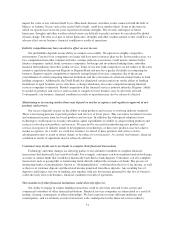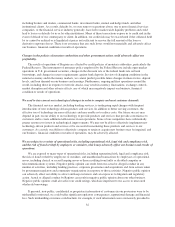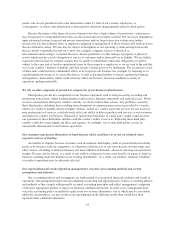Regions Bank 2010 Annual Report Download - page 37
Download and view the complete annual report
Please find page 37 of the 2010 Regions Bank annual report below. You can navigate through the pages in the report by either clicking on the pages listed below, or by using the keyword search tool below to find specific information within the annual report.lender liability is founded on the premise that a lender has either violated a duty, whether implied or contractual,
of good faith and fair dealing owed to the borrower or has assumed a degree of control over the borrower
resulting in the creation of a fiduciary duty owed to the borrower or its other creditors or shareholders.
Substantial legal liability or significant regulatory action against us or our subsidiaries could materially
adversely affect our business, financial condition or results of operations or cause significant harm to our
reputation. Additional information relating to litigation affecting Regions and our subsidiaries is discussed in
Note 23 “Commitments, Contingencies and Guarantees” to the consolidated financial statements of this Annual
Report on Form 10-K.
Further disruptions in the residential real estate market could adversely affect our performance.
As of December 31, 2010, investor real estate loans secured by land, single-family and condominium
properties, plus home equity loans secured by second liens in Florida represented approximately 8 percent of our
total loan portfolio. These portions of our loan portfolio have been under pressure for over three years and, due to
weakening credit quality, we have increased our loan loss provision and our total allowance for credit losses. In
addition, we have implemented several measures to support the management of these sections of the loan
portfolio, including reassignment of experienced, key relationship managers to focus on work-out strategies for
distressed borrowers.
While we expect that these actions will help mitigate the overall effects of the downward credit cycle, the
weaknesses in these sections of our loan portfolio are expected to continue well into 2011. Accordingly, it is
anticipated that our non-performing asset and charge-off levels will remain elevated.
Further, the effects of recent mortgage market challenges, combined with decreases in residential real estate
market prices and demand, could result in further price reductions in home values, adversely affecting the value
of collateral securing the residential real estate and construction loans that we hold, as well as loan originations
and gains on sale of real estate and construction loans. Specifically, a significant portion of our residential
mortgages and commercial real estate loan portfolios are composed of borrowers in the Southeastern United
States, in which certain markets have been particularly adversely affected by declines in real estate value,
declines in home sale volumes, and declines in new home building. For example, prices of Florida properties
remain under significant pressure, with high unemployment levels relative to periods prior to 2008 and the
continuing impact of the recent real estate downturn on the general economy. These factors could result in higher
delinquencies and greater charge-offs in future periods, which would materially adversely affect our financial
condition and results of operations. A decline in home values or overall economic weakness could also have an
adverse impact upon the value of real estate or other assets which we own upon foreclosing on a loan.
Continuing weakness in the commercial real estate market could adversely affect our performance.
The fundamentals within the commercial real estate sector remain weak, under continuing pressure from
reduced asset values, rising vacancies and reduced rents. As of December 31, 2010, approximately 19 percent of
our loan portfolio consisted of investor real estate loans. Investor real estate loans secured by land, single-family
and condominiums continue to be impacted by declining property values, especially in areas where Regions has
significant lending activities, including Florida and north Georgia. The properties securing income-producing
investor real estate loans are typically not fully leased at the origination of the loan. The borrower’s ability to
repay the loan is instead reliant upon additional leasing through the life of the loan or the borrower’s successful
operation of a business. Weak economic conditions may impair a borrower’s business operations and typically
slow the execution of new leases. Such economic conditions may also lead to existing lease turnover. As a result
of these factors, vacancy rates for retail, office and industrial space may remain at elevated levels in 2011. High
vacancy rates could result in rents falling further over the next several quarters. The combination of these factors
could result in further deterioration in the fundamentals underlying the commercial real estate market and the
deterioration of one or more loans we have made. Any such deterioration could adversely affect our financial
condition and results of operations.
23


